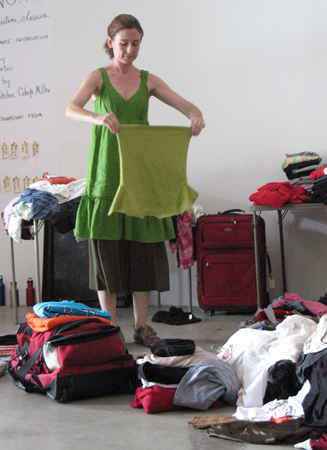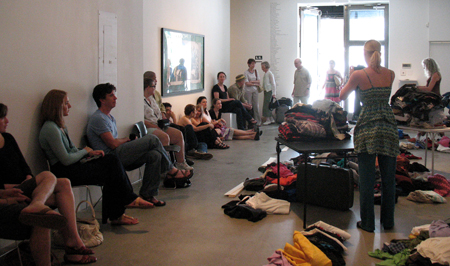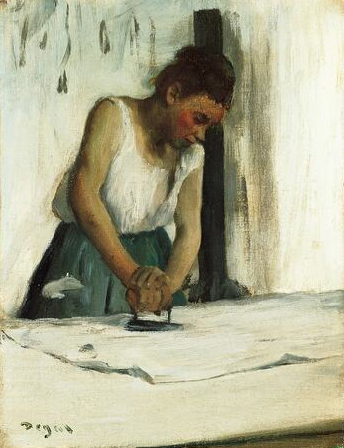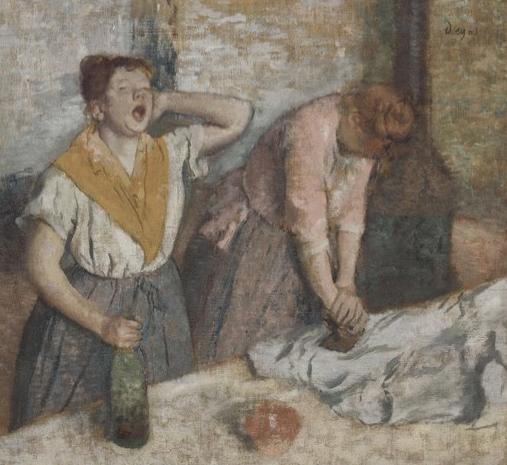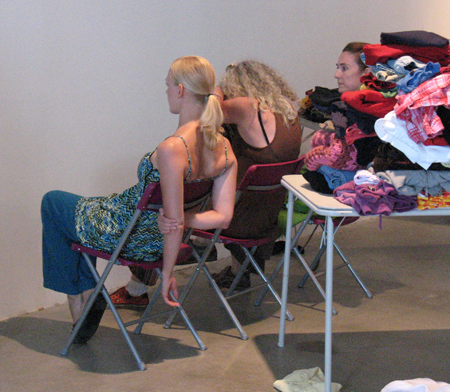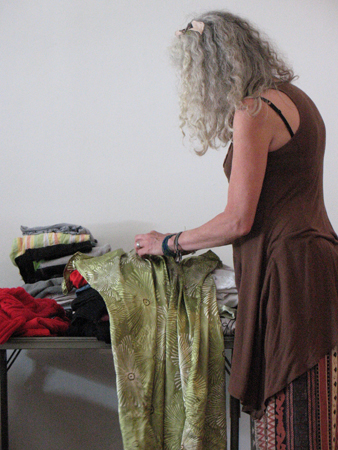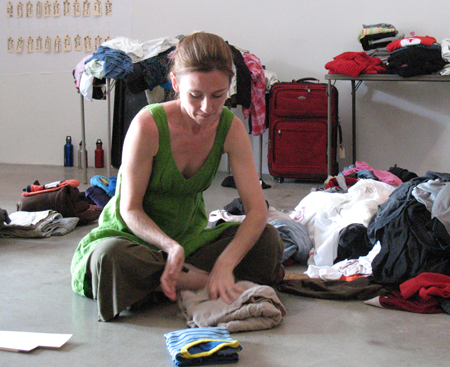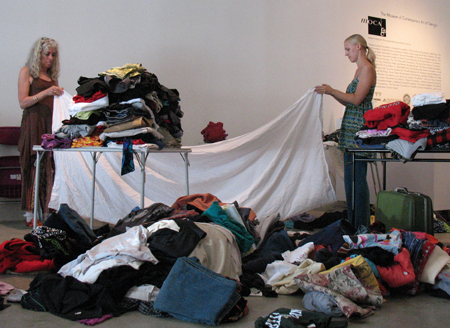There can be a purity of purpose in dance and choreography can cross over into conceptual art. The mystery of unanswered or open-ended questions about meaning, doesn’t detract from the force of the performance. I saw this on Saturday, June 23rd, when I attended “Folding”, Nicole Livieratos‘ three person, three hour draft performance in MocaGA’s lobby. Notes pinned up to the far wall of the atrium spelled out subtext of the show’s title: “Anticipatory, Routine, Closure”. The three performers included Celeste Miller, Erin Weller Dalton, and Kim Kleiber. Miller is well known locally and has directed the Choreographer’s Lab at Jacob’s Pillow Dance Festival since 1995.
My notes are cryptic:
This was a leisurely performance. The dancers went about their task of folding slowly, deliberately. At different intervals, one dancer might turn and look at another and motion stopped for a minute. At other times, a performer raised her arm as if to stretch or to mark her space. Suitcases waited in the wings – as they were filled, the performers rolled them off ‘stage’ or near the back wall.
The audience sat on the floor and in chairs along one side of the space. Being eye level with the mass of donated clothes stacked or folded enabled a more intimate interaction with the performers. The loud snap of the sheet being folded by two dancers was startling, when so close.
I was reminded of the painters who have used women in their work not merely as icons of beauty, but to comment about their era. Degas was famous for his ballet dancers, yet his depictions of French laundresses always got to me.
The Laundress. Oil on canvas 25.1 x 19.4cm. Edgar Degas, 1873. Norton Simon Art Foundation, Pasadena, CA.
Women Ironing. Oil on canvas 76 x 81.5cm. Edgar Degas, circa 1884-1886. Musée d’Orsay, Paris.
These are paintings of women who are yawning from fatigue, bent over hot irons with masses of white linen spread out on tables or hanging nearby. They slave away, washing and pressing the dirty clothes of a class far above their own. They are the paintings of a master who in the late 1800’s presented women’s labor and the singular class structure of Paris. His friend, Emile Zola, had published L’Assommoir in 1877, describing an urban laundry and the misery of the Parisian poor. Whether Degas’ intent was reflective of the naturalist and social concerns of his day or simply to depict the poetry he saw, we’ll never know.
While Livieratos isn’t strictly concerned with women’s work either – she wanted to have at least one man in the mix but couldn’t get one – she did admit that her act of folding clothes could be seen through a feminist lens. Every mother teaches her daughter to fold. Not all, myself included, readily pick up the skill.
Towards the end, all three women sat in chairs facing away from the audience and posed without moving. An arm was casually draped behind the chair or a head cradled in an elbow – as if to suggest a break in the rhythm of the task or maybe, finality.
In the action of folding as performance, many layers of meaning can be found. I return to my cryptic notes. This gentle and universal act may show the contrast between the daily bombardment of information in our lives, and a mundane and routine task. Anticipating the result of folding might be seen as order. Â The metaphor of suitcases could signify closure or moving on. Folding in – is it an addition or a loss – and what does it mean to integrate finality (mortality?) into an ongoing and complex life?
The commonality of the act, forgetting gender, is what Livieratos seems to be after. She said that she wants the piece to be read on several levels; clothing as a covering for the body in transition, disorder and order, a rhythm in brief and fleeting moments and the harmony formed when we connect with each other, or what happens when we don’t.
Reactions from the audience became a part of the performance. Some of us were moved to laughter when the piles of folded clothes fell off a card table and a dancer shrugged. Others were moved to tears.
Most of the audience remained for the duration, and offered feedback and questions during Nicole’s Q&A. Livieratos said that she was intrigued by the thought of extending the timeframe of the piece to longer than a few hours. She also wants to add a video element. There was an ambient soundtrack of backyard noises like birds, the family dog Emmie-Lou barking and at one point, a plane could be heard overhead.
Do we ever truly get a choice in our own lives or is there a constant randomness, like the clothes that were donated for this piece and the individual articles of clothing that each performer chose to pick up and fold? With a body of work that is consistently challenging, Ms. Livieratos remains open to change and said she will be finessing her ideas about sound and scale for this piece, and where the next performance might occur.

